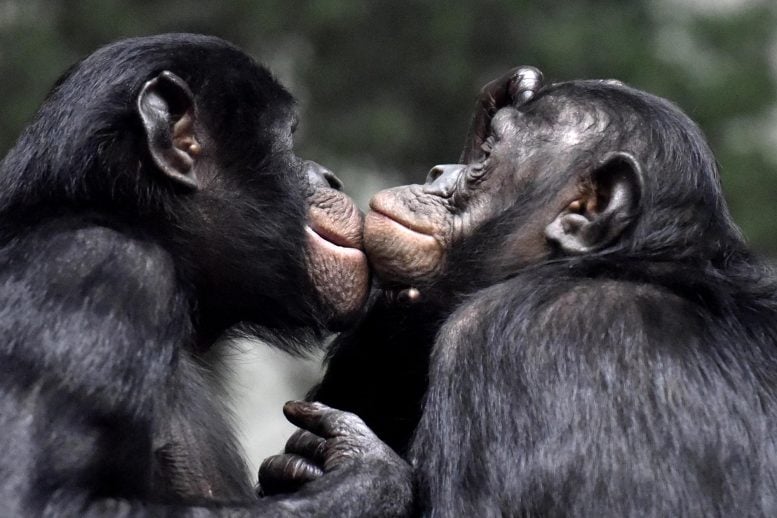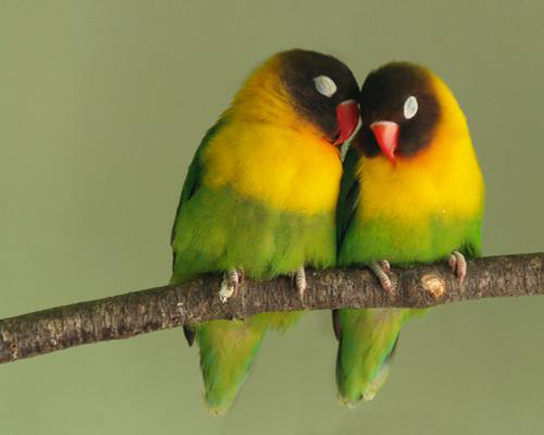
Bonobos Grooming
Computer simulations have been used to examine the sex lives of ancient hominids for many years, by measuring the circumferences of ancient bones, and by applying the rules of evolution and economics.
Currently, only 1 in 6 societies enforces monogamy as a rule. There’s evidence of monogamy going back as far as Hammurabi’s Code, dating back to 1772 BC. The practice was further codified in ancient Greece and Rome. Whilst formal concubines were frowned upon, sex with slaves wasn’t problematic. Historians call this polygynous monogamy.

Masked Lovebirds Agapornis personata. Credit: Photo by EssJayNZ/Flickr
Evolutionary psychologists say that humans aren’t the only pair-bonding species that likes extramarital affairs. Even among animals that have been known to be faithful, many don’t stay exclusive. There are few species that are completely monogamous, like the fat-tailed dwarf lemur and the Malagasy giant jumping rat.
Scientists have been trying to speculate how hominids behaved; like gorillas where most males suffered while one got to mate, or like chimpanzees where most slept around, competing for multiple partners.
In 2010, a team from Montreal analyzed the breeding ratios for Homo sapiens based upon a careful study of DNA. They measured the diversity in the human chromosome, and tried to figure out what proportion of the breeding pool had been composed of females. They found a ratio slightly more than one-to-one, implying that at least 11 females for 10 men. After making some corrections to the mathematics used, they came up with about a ratio of 2. These estimates are still within the range of societies described as monogamous or serially monogamous, although they overlapped with those characterized as polygynous.
Paleontologist Owen Lovejoy used fossil specimens as evidence for the hominids’ transition to one-on-one relationships. Ardipithecus ramidus walked on two legs, freeing its hands. This transformed the social structure of early hominids. Males and females started pairing off, and males learned how to support their families.
The transition could have also followed the laws of natural selection. Sergey Gavrilets, a researcher at the University of Tennessee, explains that the polygynous mating scheme leads to a vicious circle, where males waste their time and energy fighting over females. The overall health of the group would be improved if everyone split off into monogamous pairs. Once conflict starts over sex, there’s an evolutionary push to keep those conflicts going.
Marriage customs aren’t the same as mating strategies, but they are related. If a society gets big enough and sufficiently complex, it’s advantageous to promote monogamy. Polygamy can create problems since the multiple-wife approach leaves a lot of unmarried men around, inclined to act in risky, angry ways. These menacing bachelors increase the rates of crime and conflict, lowering productivity. In China, the preference for male babies skewed the gender ratio dramatically from 1988 to 2004. During that time, the number of unmarried men nearly doubled, and so did crime.
In India, murder rates track with male-to-female ratios across the country’s different states. It’s also possible that high rates of conflict lead to cases of polygamy. Walter Scheidel also points out that the ancient ban on multimarriage was suspended near the end of the Peloponnesian War, with so many dead soldiers that potential husbands were in short supply. This raises questions about how monogamy relates to war. Some arguments state that pair-bonding leads to stronger, larger armies that are more battle-ready whereas others suggest that men with wives are less inclined to go to war, which weakens despots and promotes democracy.
Reference: “Female-to-Male Breeding Ratio in Modern Humans—an Analysis Based on Historical Recombinations” by Damian Labuda, Jean-François Lefebvre, Philippe Nadeau and Marie-Hélène Roy-Gagnon, 25 February 2010, The American Journal of Human Genetics.
DOI: 10.1016/j.ajhg.2010.01.029









Maybe ‘scientists’ should just quit worrying about it. People do what they damned well please whether there is an official Darwinian reason for it or not.
That’s a really dumb comment. There is no little isolated class of human beings called ‘scientists’, who run around poking their noses where they don’t belong. Scientists are people who investigate real problems and seek answers for all areas of knowledge because WE collectively either want them or need them to, and to further our understanding of ourselves and the universe or invent and create technology that will benefit our civilization.
And by the way – people “doing what they damn well please” is just hard-wired behavior that arises from thousands of generations of Darwinian selection. So your comment likely comes from generations of sexually frustrated males not getting any.
“Polygyny occurs when the reproductive variance of males is greater than that of females.34 Greater variance implies that some males father more offspring than others”
This says little about if we’re monogamous though, polygyny and monogamy are not the only two options. They’re only taking into account polygyny, not other kinds of polyamory. Breeding ratio wouldn’t factor in the same way in a non exclusive polygamous type coupling. People could be sleeping around simple in the same ratios. The way they’re examining this seems skewed by the basis that everyone needs to be pair bonded and that pairing would be exclusive. Nothing in the ratio says anything about if the breeding was done in a monogamous way, just about the ratio of the breeding.
The nature of man is to adapt. It seems obvious to me that we are naturally attracted to the other sex, but decide to stay with one partner for trust etc. Perfectly natural adaption. Monogamy in most instances is beneficial to us in large societies.
The whole study seems to be build on a very false premise; Pologym is not Polygny. Get your facts straight and learn the basic difference. If homo Spains started off as monogamous the human race would have perished long ago..
I’m not sure what to believe. I would like to know what Charles Darwin said about monogamy among the early Homo-Sapiens. I attempted to google the question about monogamy and got all these responses. I’m sure there must be many circumstances which break up the tendency towards monogamy, assuming there is that tendency. We know that many mammals are monogamous under normal circumstances. I’ve read that Wolves are monogamous and some animals such as gorillas are monogamous, (I think). But I don’t know what happens upon the death of their mate. Any thoughts on any or all of this?